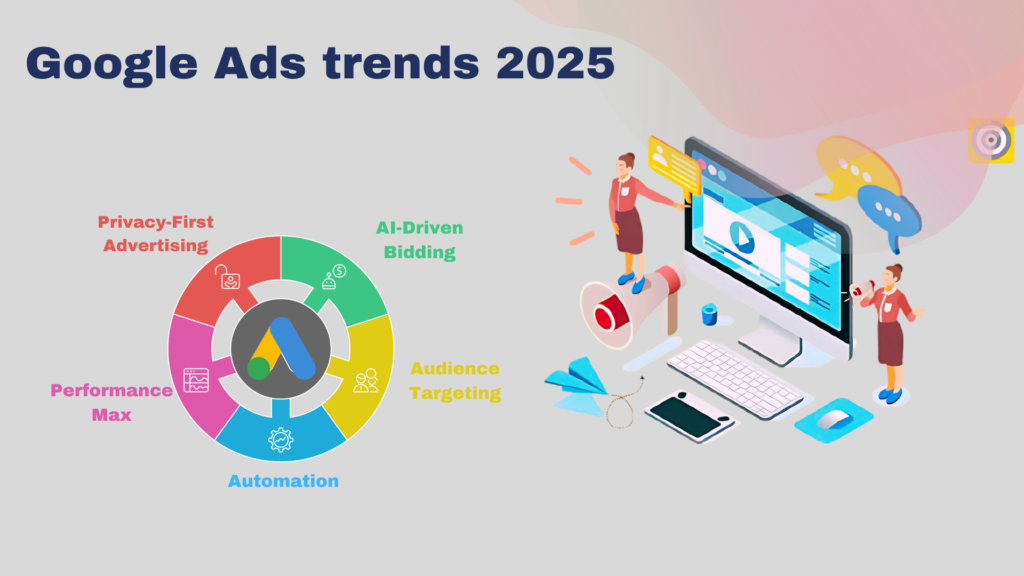Table of Contents
Toggle
Google Ads in 2025 emphasizes AI-driven bidding for optimized campaigns, personalized audience targeting, and automation for streamlined management. Performance Max campaigns offer a unified approach across Google platforms. As highlighted in Google Ads trends 2025, a focus on privacy-first advertising is crucial for adapting to evolving regulations, balancing personalization with user trust.
Here are five Google Ads trends set to redefine search engine marketing in 2025 and how you can leverage them for maximum impact.
1. AI-Driven Bidding: Automating Smarter Decisions
AI-driven bidding continues to redefine how businesses manage their ad spend. Google’s machine learning algorithms are now capable of analyzing vast data sets and adjusting bids in real-time to maximize conversions or ROAS. For marketing professionals, this means no more guesswork when it comes to optimizing ad campaigns. Instead, automated bidding decisions made by AI ensure that ads are served to the right audience at the right price.
- Why it matters: AI can identify patterns that human operators may miss, ensuring campaign optimization at scale. This level of precision saves both time and budget, especially in high-competition industries.
- Actionable Insight: Advertisers should consider moving beyond manual bid management to AI-driven bidding strategies, ensuring campaigns are continually optimized based on real-time data and changing market conditions.
2. Audience Targeting: Reaching the Right People at the Right Time
As Google Ads evolves, so does the precision of audience targeting. Leveraging data from first-party sources, along with more granular insights into user interests, behaviors, and demographics, allows businesses to serve highly relevant ads to potential customers. In 2025, marketers will need to move away from broad targeting and towards more personalized, data-informed strategies.
- Why it matters: Increased precision leads to better engagement, higher conversion rates, and an overall improved customer experience. Marketers must move towards a more individualized approach rather than mass targeting.
- Actionable Insight: Invest in audience segmentation and leverage tools such as customer match to personalize ads based on user behavior and intent, ensuring that campaigns resonate with the right individuals.
3. Automation: Achieving Efficiencies at Scale
Automation is a core part of modern SEM strategies, helping businesses streamline operations and reduce manual intervention. Google Ads offers multiple automated features, such as automated bidding, smart campaigns, and ad copy optimization, allowing campaigns to run smoothly with minimal oversight. Automation frees up marketers to focus on higher-level strategy and creative execution.
- Why it matters: The ability to automate repetitive tasks enables faster optimization and the ability to scale campaigns without proportional increases in effort or cost.
- Actionable Insight: Incorporating automated features into daily operations is essential for scaling campaigns. Start with automated bidding and expand to automated reporting and ad copy optimization to drive operational efficiency.
4. Performance Max Campaigns: Integrated Advertising Across Google Properties
Performance Max campaigns represent an all-in-one solution for managing ads across Google’s ecosystem, including Search, YouTube, Display, and Gmail. These campaigns enable advertisers to reach their target audience across multiple touchpoints through a single, integrated strategy. As Google Ads moves towards more holistic ad solutions, Performance Max will become a go-to choice for businesses aiming for maximum visibility and conversion.
- Why it matters: Performance Max campaigns eliminate the need to manage multiple, siloed campaigns across Google properties, making it easier to track performance and optimize spend in one central location.
- Actionable Insight: Marketers should embrace Performance Max to optimize their cross-channel strategy. Utilize the data from these campaigns to refine audience targeting and measure the success of campaigns across multiple platforms.
5. Privacy-First Advertising: Adapting to New Regulations
As privacy concerns grow, so do regulations like GDPR and CCPA. Google Ads is prioritizing privacy-first advertising, enabling advertisers to comply with legal requirements while still running effective campaigns. The key challenge lies in balancing personalization with privacy. In 2025, businesses will need to adapt by leveraging first-party data and adjusting targeting methods to comply with these regulations.
- Why it matters: Adopting privacy-first strategies builds trust with consumers and ensures long-term sustainability in ad campaigns. As third-party cookies phase out, using privacy-compliant data will be essential to maintaining advertising effectiveness.
- Actionable Insight: Focus on gathering and leveraging first-party data to build customer profiles. Explore Google Ads’ privacy-focused tools like enhanced conversions to maintain performance without breaching privacy regulations.
Actionable Next Steps:
For those looking to stay ahead of the curve in 2025, incorporating these Google Ads trends into your SEM strategy is non-negotiable. By shifting to AI-driven bidding, refining audience targeting, embracing automation, utilizing Performance Max campaigns, and prioritizing privacy, your business can ensure that its advertising efforts remain effective and compliant with evolving market dynamics. Now is the time to integrate these shifts into your marketing strategy to improve performance, enhance customer experience, and drive better ROI.
